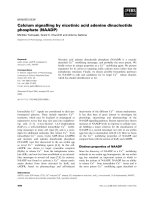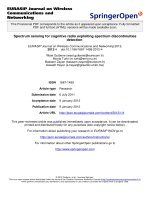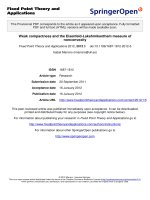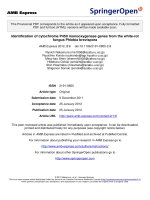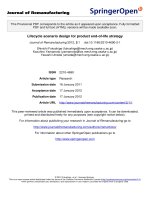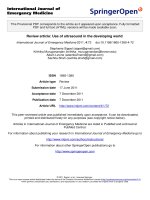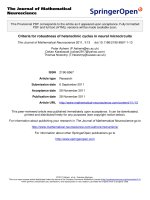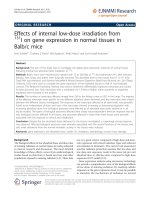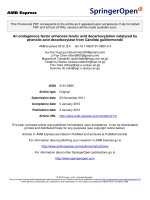Báo cáo toán học: " decarboxylation catalyzed by phenolic acid decarboxylase from Candida guilliermondii" potx
Bạn đang xem bản rút gọn của tài liệu. Xem và tải ngay bản đầy đủ của tài liệu tại đây (708.97 KB, 44 trang )
This Provisional PDF corresponds to the article as it appeared upon acceptance. Fully formatted
PDF and full text (HTML) versions will be made available soon.
An endogenous factor enhances ferulic acid decarboxylation catalyzed by
phenolic acid decarboxylase from Candida guilliermondii
AMB Express 2012, 2:4 doi:10.1186/2191-0855-2-4
Hui-Kai Huang ()
Li-Fan Chen ()
Masamichi Tokashiki ()
Tadahiro Ozawa ()
Toki Taira ()
Susumu Ito ()
ISSN 2191-0855
Article type Original
Submission date 23 November 2011
Acceptance date 4 January 2012
Publication date 4 January 2012
Article URL />This peer-reviewed article was published immediately upon acceptance. It can be downloaded,
printed and distributed freely for any purposes (see copyright notice below).
Articles in AMB Express are listed in PubMed and archived at PubMed Central.
For information about publishing your research in AMB Express go to
/>For information about other SpringerOpen publications go to
AMB Express
© 2012 Huang et al. ; licensee Springer.
This is an open access article distributed under the terms of the Creative Commons Attribution License ( />which permits unrestricted use, distribution, and reproduction in any medium, provided the original work is properly cited.
1
An endogenous factor enhances ferulic acid decarboxylation catalyzed by phenolic
acid decarboxylase from Candida guilliermondii
Hui-Kai Huang
1
, Li-Fan Chen
2
, Masamichi Tokashiki
2
, Tadahiro Ozawa
3
, Toki Taira
2
and Susumu Ito
2*
1
United Graduate School of Agricultural Sciences, Kagoshima University, Kagoshima,
Kagoshima 890-0065, Japan
2
Department of Bioscience and Biotechnology,
University of the Ryukyus, Nishihara, Okinawa 903-0213, Japan
3
Tochigi Research
Laboratories of Kao Corporation, Ichikai, Haga, Tochigi 321-3497, Japan
HKH ()
LFC ()
MT ()
TO ()
TT ()
SI ()
*Corresponding author. Mailing address: Department of Bioscience and Biotechnology,
University of the Ryukyus, Nishihara, Okinawa 903-0213, Japan; Tel.:
+81-98-895-8804; E-mail:
2
Abstract
The gene for a eukaryotic phenolic acid decarboxylase of Candida guilliermondii was
cloned, sequenced, and expressed in Escherichia coli for the first time. The structural
gene contained an open reading frame of 504 bp, corresponding to 168 amino acids with
a calculated molecular mass of 19,828 Da. The deduced amino sequence exhibited low
similarity to those of functional phenolic acid decarboxylases previously reported from
bacteria with 25–39% identity and to those of PAD1 and FDC1 proteins from
Saccharomyces cerevisiae with less than 14% identity. The C. guilliermondii phenolic
acid decarboxylase converted the main substrates ferulic acid and p-coumaric acid to the
respective corresponding products. Surprisingly, the ultrafiltrate (Mr 10,000-cut-off) of
the cell-free extract of C. guilliermondii remarkably activated the ferulic acid
decarboxylation by the purified enzyme, whereas it was almost without effect on the
p-coumaric acid decarboxylation. Gel-filtration chromatography of the ultrafiltrate
suggested that an endogenous amino thiol-like compound with a molecular weight
greater than Mr 1,400 was responsible for the activation.
Keywords: phenolic acid decarboxylase, ferulic acid decarboxylase, p-coumaric acid
decarboxylase, Candida guilliermondii, activator
3
Introduction
Ferulic acid (FA), a derivative of 4-hydroxycinnamic acid, is found in cell walls
primarily as an ester linked to lignin and other polysaccharides in cell walls, leaves and
seeds of plants such as in rice, wheat, and oat (Mathew and Abraham 2004). Bacterial
phenolic acid decarboxylases (PADs), which decarboxylate FA, p-coumaric acid (PCA),
and/or caffeic acid (CA) with
concomitant production of 4-vinylguaiacol (4VG),
4-vinylphenol (4VP), and/or 4-vinylcatechol, respectively (see Additional file 1), are
responsible for the detoxification of these 4-hydroxycinnamic acids (Huang et al. 1994;
Degrassi et al. 1995; Cavin et al. 1997b, 1998). Zago et al. (1995) first succeeded in
sequencing and expression of a bacterial PAD (FA decarboxylase from Bacillus
pumilus) in Escherichia coli. The genetic mechanism of bacterial PAD expression has
been well established by the discovery of PadR-mediated response to
4-hydroxycinnamic acids in Pediococcus pentosaceus (Barthelmebs et al. 2000),
Bacillus subtilis (Tran et al. 2008), and Lactobacillus plantarum (Gury et al. 2009). The
4VG formed is valuable precursor in the biotransformation of flavors and fragrances
used in the food, pharmaceutical, and cosmetic industries (Mathew and Abraham 2006;
Priefert et al. 2001). Furthermore, this compound is sometimes present as an aroma in
beers and wines (Thurston and Tubb 1981; Smit et al. 2003; Coghe et al. 2004; Oelofse
4
et al. 2008; Sáez et al. 2010)
Naturally-occurring phenolic acids are known to inhibit the growth of yeasts such as
Saccharomyces cerevisiae, Pichia anomala, Debaryomyces hansenii, and Candida
guilliermondii (Meyerozyma guilliermondii comb. nov.; Kurtzman and Suzuki 2010)
(Baranowski et al. 1980; Stead 1995; Pereira et al. 2011). S. cerevisiae (Goodey and
Tubb 1982; Clausen et al. 1994; Smit et al. 2003; Coghe et al. 2004), Brettanomyces
bruxellensis (Godoy et al. 2008), and C. guilliermondii (Huang et al. 2011) are
suggested to produce a PAD in response or relation to 4-hydroxycinnamic acids.
Recently, we purified and characterized a highly active substrate-inducible PAD
from C. guilliermondii ATCC 9058 (CgPAD) (Huang et al. 2011). CgPAD is heat-labile,
and its molecular mass determined by SDS-polyacrylamide gel electrophoresis is about
20 kDa, which is similar to those of yeast strains of Brettanomyces anomalus (Edlin et
al. 1998) and B. bruxellensis (Godoy et al. 2008). CgPAD was active toward
4-hydroxycinnamic acid derivatives, PCA, FA, and CA, whose relative activity ratios
are different from the PADs of B. anomalus and B. bruxellensis.
In the case of C. guilliermondii ATCC 9058, CgPAD may be induced by both PCA
and FA, because the ratios of decarboxylation activity toward FA to PCA in the cell-free
extracts were comparable to that of the purified enzyme. However,
5
6-hydroxy-2-naphthoic acid (6H2N) induced CgPAD 20- and 6-fold greater than FA and
PCA, respectively, and the ratios of decarboxylation activity toward FA to PCA in the
cells grown on different carbon sources in the presence of the pseudo-inducer were
found to be increased remarkably (Huang et al. 2011). There was a possibility that
6H2N induced another FA decarboxylase distinct from CgPAD under a defined
condition, but such activity was not detectable during the course of purification. In the
present study, to resolve this inconsistency, we sequenced the gene for CgPAD and
created recombinant enzymes. Unexpectedly, we found that the presence of
dithiothreitol (DTT), 2-mercaptoethanol, cysteine, and homocysteine considerably
accelerated the rates of FA decarboxylation activity of the purified native and
recombinant CgPAD, while they did not affect those of their PCA decarboxylation
activity. We also demonstrated that an unidentified amino thiol-like compound in the
ultrafiltrate of the C. guilliermondii cell-free extract enhanced the FA decarboxylation
activity specifically.
Materials and methods
Materials
FA, CA, 4VG, and 6H2N were purchased from Wako Pure Chemical (Osaka, Japan).
6
PCA was from MP Biomedicals (Solon, OH), and 4VP was from Sigma-Aldrich
(Steinheim, Germany). All other chemicals used were of analytical grade.
Microorganisms and propagation
The source of PAD and its gene was C. guilliermondii (M. guilliermondii) ATCC 9058.
The enzyme was induced aerobically by 6H2N (1 mM) in Yeast Nitrogen Base (YNB;
Invitrogen, Carlsbad, CA) broth containing 0.5% glucose as described (Huang et al.
2011). Briefly, the yeast was grown at 25ºC for 1 d, with shaking, in 200-ml portions of
the medium placed in 2-l flasks. E. coli DH5α (Takara Bio, Otsu, Japan) and E. coli
BL21 (DE3) (Takara Bio) were used for plasmid preparation and sequencing and for
expression and purification of recombinant CgPAD, respectively. The transformed E.
coli cells were grown, with shaking, at 37ºC in 50-ml portions of Luria-Bertani broth
plus ampicillin (100 µg ml
-1
) placed in 500-ml flasks to an A
600
of 0.5. After adding
isopropyl β-D-galactosyl pyranoside (0.1 mM) to the culture, incubations were further
continued at 18ºC for 24 h. After cells were collected by centrifugation (12,000 × g for
10 min) at 4ºC, cell pastes obtained from 600-ml culture were used as the starting
materials for enzyme purification.
7
Purification of native and recombinant forms of CgPAD
Enzyme purification was done at a temperature not exceeding 4ºC. The native CgPAD
in C. guilliermondii was purified by successive column chromatographies on CM
Toyopearl 650M (Tosoh, Tokyo, Japan), DEAE Toyopearl 650M (Tosoh), and Bio-Gel
P-100 (Bio-Rad, Hercules, CA) columns, as described previously (Huang et al. 2011).
The wild-type and mutant recombinant enzymes highly expressed in E. coli cells
were each purified by essentially the same procedure as that of the native enzyme
(Huang et al. 2011). The recombinant E. coli cells were washed twice with saline and
then suspended in two volumes of the extraction buffer [20 mM sodium phosphate
buffer (pH 7.0) plus 1 mM each of phenylmethanesulfonyl fluoride, MgCl
2
, EDTA, and
DTT]. The cells were disrupted six times for 50 s each with glass beads (0.5 mm in
diameter) at 2,500 rpm in a homogenizer (Multi-Beads Shocker; Yasui Kikai, Osaka,
Japan). After cell debris was removed by centrifugation (12,000 × g, 15 min), the
supernatant obtained was applied directly to a column of DEAE Toyopearl 650M (2.5
cm × 25.5 cm) previously equilibrated with 20 mM 2-morpholinoethanesulfic
acid/NaOH (MES) buffer (pH 6.5). The column was initially washed with 200 ml of 50
mM NaCl in MES buffer (pH 6.5), and proteins were eluted with a 300-ml linear
gradient of 50 mM to 0.5 M NaCl in the buffer. The active fractions were immediately
8
concentrated and exchanged with 50 mM phosphate buffer (pH 7.0) by ultrafiltration
(Amicon Ultra-15; Millipore, Billerica, MA) to a small volume. The concentrate was
then put on a column of Bio-Gel P-100 (1.0 cm × 43 cm) equilibrated with 50 mM
sodium phosphate buffer (pH 7.0) and eluted with the equilibration buffer. The active
fractions were combined and concentrated by ultrafiltration, and the concentrate was
stored at –20ºC until use. Highly purified wild-type and mutant recombinant enzymes
were obtained approximately 2- to 5-folds with yields of 40–70% within 2 d by the
simple purification procedure as judged by SDS-acrylamide gel electrophoresis (see
Additional file 2).
Assay of CgPAD activity
The enzyme assay method was essentially the same as described previously (Huang et
al. 2011). The initial velocity of decarboxylation activity was measured at 25ºC with
4-hydroxycinnamic acid as substrate. The reaction mixture contained the
suitably-diluted enzyme solution and a 5 mM substrate (neutralized with 1.0 N NaOH)
in 0.1 M sodium phosphate buffer (pH 6.0) in a final volume of 1.0 ml. After the
reactions were terminated by boiling for 10 min, the products formed were quantified
by high-performance liquid chromatography (HPLC) using a packed column for
9
reversed phase chromatography (Cosmosil 5C18-MS-II, 4.6 mm × 150 mm; Nacalai
Tesque, Tokyo, Japan) with acetonitrile/0.05% phosphoric acid (7:3, v/v) as the mobile
phase at a flow rate of 0.6 ml min
-1
. One U of enzyme activity was defined as the
amount of enzyme that released 1 µmol of 4VG or 4VP per min. Because the product,
4-vinylcatechol, from CA was not commercially available, the CA decarboxylation
activity was expressed as formation of 4VG. Protein concentrations were measured
using a BCA protein assay kit (Thermo Fisher Scientific, Rockville, MD) with bovine
serum albumin as the standard.
Sequencing of internal amino acid residues of CgPAD
Initially, peptides of native CgPAD were obtained by treatment with CNBr or
Staphylococcus aureus V8 protease. The CNBr cleavage was done essentially by the
method of Steers et al. (1965). One mg of CgPAD was dissolved in 0.2 ml of 70%
formic acid and cleaved with an excess of CNBr at room temperature for 24 h. After the
remaining CNBr was removed by a rotary evaporator, the reaction mixture was filtered
on a column of TSK gel G2000SWXL (Tosoh, 0.78 cm × 30 cm) in 30% acetic acid.
The digestion of CgPAD with V8 protease was performed at 37ºC for 6 h in 50 mM
ammonium bicarbonate buffer (pH 7.8) plus 4 M urea and 2 mM EDTA. The peptide
10
fragments obtained were fractionated by reverse-phase high-performance liquid
chromatography on a C4 column (3.9 mm × 150 mm, Waters, Milford, MA). The amino
acid sequences of peptides derived from CNBr or V8 protease digestion of native
CgPAD were determined by automated sequential Edman degradation using a
PPSQ-23A protein sequencing system (Shimadzu, Kyoto, Japan).
Cloning and sequencing of CgPAD gene
All primers used are presented in Additional file 3. By a reverse transcription
polymerase chain reaction using appropriate degenerate primers, the internal cDNA
fragments of CgPAD were sequenced. Total RNA was isolated from C. guilliermondii
using an RNeasy kit (Qiagen, Valencia, CA). First-strand cDNA synthesis was
performed with 5 µg of total RNA using a GeneRacer kit (Invitrogen, Carlsbad, CA)
with oligo(dT) adaptor primer. The cDNA obtained was used as a template for PCR
amplification with degenerate primers. The first PCR was performed with primers P1 (a
forward primer designed from an internal LKNKHFQYTYDNGWKYEFHV) and P2 (a
reverse primer designed from an internal AFSQGHWEHPEQAHGDKRED), and nested
PCR was done with P1 and P3 (a reverse primer designed from an internal
AFSQGHWEHPEQAHGDKRED) (the sequences used for primer design are
11
underlined). The nested PCR product was then cloned into a pGEM-T vector (Promega,
Madison, WI) and sequenced using the ABI Prism system (Model 310; Applied
Biosystems, Foster City, CA).
To obtain the entire gene for CgPAD, both 5’ and 3’ rapid amplification of cDNA
ends (RACE) were performed using a GeneRacer kit according to the manufacturer’s
instructions. The gene-specific primers P4 (first PCR) and P5 (nested PCR) were used
for the 5’-RACE and the gene-specific primers P6 (first PCR) and P7 (nested PCR) for
the 3’-RACE. Approximately 250 bp and 290 bp were amplified by 5’-RACE and
3’-RACE, respectively. Finally, a cDNA fragment containing the entire coding region
of CgPAD cDNA was amplified using the forward primer P8 (designed from the
5’-RACE product) and reverse primer P9 (designed from the 3’-RACE product).
The nucleotide sequence of CgPAD was submitted to DDBJ under the accession
number AB663499
Site-directed mutagenesis
The entire CgPAD gene was amplified by PCR and cloned into the NdeI/HindIII site of
pET-22b (+) (Novagen, Darmstadt, Germany), yielding the construct designated
pPAD22b. Amino acid replacements were performed using a QuikChange II
12
site-directed mutagenesis kit (Stratagene, La Jolla, CA). PCR was performed using
PfuUltra HF DNA polymerase (Promega) with pPAD22b as the template. The primer
sets used were
5’-CATGGGGGGCCACTG
GCTGGACGGCAC-3’/5’-GTGCCGTCCAGCCAGTGGC
CCCCCATG-3’ for the Met57→Leu (M57L) mutation,
5’-CATGGGGGGCCAACGGCTGGACGGCAC-3’/5’-GTGCCGTCCAGCCGTTGGC
CCCCCATG-3’ for the M57T mutation, and
5’-CATGGGGGGCCAGCGGCTGGACGGCAC-3’/5’-GTGCCGTCCAGCCGCTGG
CCCCCCATG-3’ for the M57A mutation (the underlined sequences indicate mutated
codons). To express mutant proteins, the resulting plasmids harboring the respective
mutated genes were each introduced into competent E. coli BL21 (DE3) cells.
Construction of model structure of CgPAD
The secondary structure of CgPAD was predicted by the method of Kabsch and Sander
(1983). The deduced amino acid sequence of the enzyme was aligned with that of the
crystal structure of a PAD (PCA decarboxylase) from L. plantarum (LpPAD; PDB code
2GC9) (Rodríguez et al. 2010). A model of the CgPAD structure built with method of
homology modeling was constructed based on the structure of LpPAD (Sali et al. 1993).
13
All data sets were processed on a Windows XP personal computer using the Discovery
Studio software package (Accelrys, San Diego, CA). Distance between intramolecular
sulfur atom of methionine and side-chain carbonyl oxygen atoms of glutamic acid or
amide nitrogen atom of arginine was calculated from the coordinate values. The figure
was prepared using a DS Visualizer (Accelrys).
Results
Nucleotide and deduced amino acid sequences of CgPAD
We initially cloned and sequenced the CgPAD gene. The entire CgPAD gene was 504
nucleotides in length, and an open reading frame encoded 168 amino acid residues
(Figure 1). The calculated molecular mass was 19,828 Da
( a value very close to the 20 kDa determined for
the native enzyme by SDS-polyacrylamide gel electrophoresis (Huang et al. 2011).
The deduced amino acid sequence of CgPAD was aligned with those of functional
PADs reported to date from different bacteria (Thompson et al. 1997;
As shown in Figure 2, CgPAD exhibited
very low similarity of sequence to functional PADs reported to date from L. plantarum
WCFS1 (Rodríguez et al. 2010) and L. plantarum LPCHL2 (Cavin et al. 1997a) with
14
39%, Enterobacter sp. Px6-4 (Gu et al. 2011a, 2011b) with 34%, Klebsiella oxytoca
(Uchiyama et al. 2008) with 27%, and B. subtilis 168 (Cavin et al. 1998) with 26%
identity, and B. pumilus PS213 (Zago et al.1995), P. pentosaceus ATCC 25745
(Barthelmebs et al. 2000), and Lactobacillus brevis ATCC 367 (RM84) (Landete et al.
2010) each with 25% identity. Nevertheless, four residues (Tyr18, Tyr20, Arg48, and
Glu71) involved in the catalysis of LpPAD (Rodríguez et al. 2010) were well conserved
in CgPAD as Tyr30, Tyr32, Arg60 [but Asn23 in the Enterobacter enzyme (Gu et al.
2011b)], and Glu82 and of PADs from other bacteria as these residues at the
corresponding positions.
Construction of model structure and creation of mutant proteins of CgPAD
The absence and/or replacement of methionine residues adjacent to catalytic residues or
in the proximate area of active-site pockets has been reported to confer resistance to
oxidation, as based on the catalytic activity of enzymes (Estell et al. 1985; Hagihara et
al. 2001, 2003; Nonaka et al. 2003). Further, we demonstrated that the replacement or
oxidation of such the Met residues altered the conversion rates of substrates by some
enzymes (Hagihara et al. 2001, 2003; Nonaka et al. 2003, 2004; Saeki et al. 2007).
Then, we first postulated that the fluctuation of the ratio of decarboxylation toward FA
to PCA might result from oxidation of heat-labile CgPAD, because the deduced amino
15
acid sequence contained two oxidizable Met residues at positions 57 and 103 (Figure 1).
It was expected that the replacement of either Met57 or Met 103 with the
non-oxidizable amino acids would increase the ratio of decarboxylation activity of
CgPAD toward FA to PCA.
According to this scenario, we constructed a model of CgPAD using the crystal
structure of LpPAD (PDB code 2GC9) as the template. In the result, the Met residues at
positions 57 and 103 in the modeled CgPAD appeared to be located in the active-site
pocket (see Additional file 4). Especially, the Met57 residue is located at the entrance of
the pocket and in the immediate vicinity of possible catalytic residues Arg60 and Glu82.
However, the Met103 residue is spatially more distant from the two catalytic residues
and located deeper in the active-site pocket (see Additional file 5).
Therefore, we selected the Met57 residue as the target for site-directed mutagenesis
and created the mutant enzymes with M57L, M57T, and M57A. The recombinant
wild-type and mutant enzymes expressed in E. coli cells, together with the native
enzyme from C. guilliermondii, were each purified to homogeneity (see Additional file
2). Contrary to our expectation, a mutant enzyme with M57L did not increase the ratio of
decarboxylation activity of CgPAD toward FA to PCA compared with the native and
recombinant wild-type enzymes, as shown in Table 1. The activities toward both
16
substrates of the mutants with M57T and M57A were practically negligible.
Acceleration of FA decarboxylation activity of CgPAD by thiol compounds
For measurement of enzyme activities in the cell-free extracts, we disrupted the cells in
the extraction buffer supplemented with 1 mM DTT. Then, we examined the effect of
this thiol on the activity of purified native CgPAD. As the result, the FA decarboxylation
activity was found to be enhanced by DTT at 0.2–1 mM (Figure 3), while the PCA
decarboxylation activity was not affected by DTT at the concentrations examined.
To further understand the unexpected positive effect of DTT, we examined the
effects of various thiol-containing amino acids and chemical reagents on both activities.
Positive effects on the FA decarboxylation activity were also observed with
2-mercaptoethanol (5 mM) and sulfhydryl amino acids such as L-cysteine, D-cysteine,
and DL-homocysteine (1 mM each), and the increases in the relative decarboxylation
activities of FA to PCA reached 2:1 to 3:1 when compared with the control (without
thiol), as shown in Table 2. Cysteic acid (1 mM) was essentially without effect.
The possibility that the replacement of Met57 with leucine disrupted the structural
proper folding of CgPAD was not excluded because its specific activity was
considerably lower than those of the native and wild-type enzymes (Table 1). However,
17
the positive effect by L-cysteine (1 mM) on FA decarboxylation activity was also
observed with the M57L mutant enzyme as well as with native and recombinant
wild-type forms, as shown in Table 3. Essentially, L-cysteine was without effect on the
decarboxylation activity toward CA of the wild-type enzyme. The activity toward CA of
the M57L mutant enzyme was too low to evaluate the effect of L-cysteine.
Activation of FA decarboxylation activity by ultrafiltrate of cell-free extract
Finally, we supposed that C. guilliermondii inherently possessed a physiological thiol
activator, which might have been removed during the enzyme purification. Then, we
prepared an ultrafiltrate of the cell-free extract (Mr 10,000-cut-off) of induced C.
guilliermondii cells and incubated it with native and recombinant CgPADs at 25ºC for
20 min before enzyme assays. As the results shown in Figure 4, the ultrafiltrate was
found to remarkably increase the FA decarboxylation activities of both enzymes
(approximately up to 5-folds) with an increase in its volume, while it exhibited little
effect on their PCA and CA decarboxylation activities. The ultrafiltrate of the cell-free
extract of recombinant E. coli did not exhibit such an activation effect.
Partial purification of true activator in the ultrafiltrate
18
The ultrafiltrate was subjected to gel-filtration chromatography on Bio-Gel P-2. As
shown in Figure 5, a possible true activator associated with the FA decarboxylation
activity was detected in fractions corresponding to a Mr larger than 1,400. The fractions
reacted positively with the 5,5’-dithio-bis(2-nitrobenzoic acid) (DTNB) and ninhydrin
reagents. In the presence of 50 µl of the filtrate, the values of K
m
, k
cat
, and k
cat
/K
m
for FA
were 5.67 mM, 278 s
-1
, and 49.0 s
-1
mM
-1
, whereas those of the control (without filtrate)
were 5.31 mM, 89.7 s
-1
, and 16.9 s
-1
mM
-1
, respectively.
Discussion
This study describes for the first time the cloning, sequencing, and expressing the gene
for a eukaryotic PAD in E. coli. CgPAD exhibited very low sequence similarity to
reported functional PADs with 24–39% identity. CgPAD showed 100% amino acid
sequence identity to a hypothetical protein (EDK35930; locus tag PGUG_00028) in the
genome of the yeast M. guilliermondii ATCC 6260 (AAFM00000000), and moderate
similarity (51–56% identity) to the internal sequences of hypothetical proteins of
unknown function in the genomes of fungi including the genera Verticillium,
Neosartorya, Aspergillus, Schizophyllum, Ustilago, Sporisorium, Nectria, Gibberella,
and Penicillium (data not shown). Notably, CgPAD exhibited sequence similarity to
19
PAD1 (YDR538W) with less than 14% identity and essentially no homology with
FDC1 (YDR539W) isolated from S. cerevisiae (Clausen et al. 1994; Mukai et al. 2010).
There was a possibility that either Met57 or Met103 in CgPAD was located in the
active-site pocket and oxidized to methionine sulfoxide during growth or purification.
Accordingly, the massive sulfoxide group of the oxidized Met residue in the CgPAD
might hinder the entry of FA (4-hydroxy-3-methoxycinnamic acid) due to its 3-methoxy
group, but not PCA (4-hydroxycinnamic acid), to the active-site pocket. To understand
the fluctuation of the ratio of decarboxylation toward FA to PCA of CgPAD, we
constructed a model structure of the enzyme and replaced the Met57 residue located at
the entrance of the pocket with non-oxidizable amino acids by site-directed mutagenesis.
However, a mutant enzyme (M57L) did not increase the decarboxylation ratio of FA to
PCA, for instance. This may exclude the possibility that oxidation of Met57, close to the
catalytic residues Arg60 and Glu82, alters the decarboxylation ratio of FA to PCA. A
single Cys residue at position 66 could be responsible for the alteration of CgPAD
activity. However, in the model of CgPAD we built, the Cys66 residue is located deeper
in the active-site pocket and faced on the other side and far distant (7.2 Å) from the
indole ring of Trp80 which might interact with Glu82 (data not shown). Essentially,
conversion of cysteine to cysteic acid during purification steps is unlikely because
20
cysteine is oxidized by strong chemical oxidants.
In this study, the activities toward substrates of the M57T and M57A mutants,
together with M57L mutant, were found to be much lower than those of the native and
recombinant wild-type forms of CgPAD. This result suggests that Met57 is one of the
substrate-binding residues in the catalysis of CgPAD. In support of our view, one of
substrate-binding residues, Leu45, in the Enterobacter PAD (Gu et al. 2011b) is
conserved as Met at the corresponding positions in the aligned bacterial enzymes. The
corresponding residue in CgPAD is Met57 in the model structure of CgPAD (see
Additional file 4).
Unexpectedly, we found that the rate of FA decarboxylation activity, but not PCA
decarboxylation activity, of CgPAD was accelerated by DTT, 2-mercaptoethanol,
cysteine (both L- and D-forms), and DL-homocysteine, which are antioxidants and/or
reducing reagents. However, these chemical reagents cannot reduce oxidized Met
residues (methionine sulfoxide and methionine sulfonate) in protein molecules.
Furthermore, L-cysteine and L-homocysteine are involved in the trans-sulfurization of
amino acid metabolism (e.g., Brosnan and Brosnan 2006), both of which intracellular
concentrations are very lowered by strict regulatory control. These results exclude the
possibility that these amino acids are the physiological activator for CgPAD.
21
Finally, we found that an amino thiol-like endogenous factor in the ultrafiltrate of
the C. guilliermondii cell-free extract drastically enhanced the FA decarboxylation
activity. The kinetic data indicate that the ultrafiltrate increases the maximal activity
toward FA without altering of the affinity to the substrate. These findings led us to
conclude that a true activator for FA decarboxylation activity is inherently present in the
C. guilliermondii cells. This also shows that the true activator was removed during the
enzyme purification. Such a catalytic nature has never been reported in the literature.
Identification of the structure of the endogenous activator would explain the novel
catalytic feature of CgPAD and contribute to the clarification of physiological role of
PADs in some yeast cells. It is interesting to examine whether such activation of
eukaryotic PADs is observed by ultrafiltrates of prokaryotes and vice versa.
Rodríguez et al. (2010) clarified by site-directed mutagenesis of Arg48 and Glu71 in
LpPAD that the entrance region, particularly the β1–β2 and β3–β4 loops, adopted a
distinct closed conformation that decreased the opening of the active-site cavity.
Possible subsite residues Tyr30 and Tyr32 and catalytic residue Glu82 along with Met57
of CgPAD are located on the β1–β2 loop and β3–β4 loop, respectively (see Additional
file 4 A). It is possible that the physiological activator in the ultrafiltrate and/or the
tested thiol compounds induce conformational change of the loops so that the entry of
22
FA is much easier than those of PCA and CA. CgPAD exhibits low sequence similarity
to LpPAD of known structure, and we are now crystalizing CgPAD to solve its X-ray
structure.
Competing interests
The authors declare that they have no competing interests.
References
Baranowski JD, Davidson PM, Nagel CW, Branen AL (1980) Inhibition of
Saccharomyces cerevisiae by naturally occurring hydroxycinnamates. J Food Sci
45:592–594. doi:10.1111/j.1365-2621.1980.tb04107.x.
Barthelmebs L, Lecomte B, Diviès C, Cavin JF (2000) Inducible metabolism of
phenolic acids in Pediococcus pentosaceus is encoded by an autoregulated operon
which involves a new class of negative transcriptional regulator. J Bacteriol
182:6724–6731. doi:10.1128/JB.182.23.6724-6731.2000.
Brosnan JT, Brosnan ME (2006) The sulfur-containing amino acids: an overview. J
Nutr 136:1636S-1640S.
23
Cavin JF, Barthelmebs L, Diviès C (1997a) Molecular characterization of an inducible
p-coumaric acid decarboxylase from Lactobacillus plantarum: gene cloning,
transcriptional analysis, overexpression in Escherichia coli, purification and
characterization. Appl Environ Microbiol 63:1939–1944.
Cavin JF, Barthelmebs L, Guzzo J, Beeumen JV, Samyn B, Travers JF, Diviès C
(1997b) Purification and characterization of an inducible p-coumaric acid
decarboxylase from Lactobacillus plantarum. FEMS Microbiol Lett 147:291–295.
doi:10.1016/S0378-1097(97)00004-9.
Cavin JF, Dartois V, Diviès C (1998) Gene cloning, transcriptional analysis, purification,
and characterization of phenolic acid decarboxylase from Bacillus subtilis. Appl
Environ Microbiol 64:1466–1471.
Clausen M, Lamb CJ, Megnet R, Doerner PW (1994) PAD1 encodes phenylacrylic acid
decarboxylase which confers resistance to cinnamic acid in Saccharomyces
cerevisiae. Gene 142:107–112. doi:10.1016/0378-1119(94)90363-8.
Coghe S, Benoot K, Delvaux F, Vanderhaegen B, Delvaux FR (2004) Ferulic acid
release and 4-vinylguaiacol formation during brewing and fermentation:indications
for feruloyl esterase activity in Saccharomyces cerevisiae. J Agric Food Chem
52:602–608. doi:10.1021/jf0346556.
24
Degrassi G, Polverino de Laureto P, Bruschi CV (1995) Purification and
characterization of ferulate and p-coumarate decarboxylase from Bacillus pumilus.
Appl Environ Microbiol 61:326–332.
Edlin DAN, Narbad A, Gasson MJ, Dickinson JR, Lloyd D (1998) Purification and
characterization of hydroxycinnamate decarboxylase from Brettanomyces anomalus.
Enzyme Microb Technol 22:232–239. doi:10.1016/S0141-0229(97)00169-5.
Estell DA, Graycar TP, Wells JA (1985) Engineering an enzyme by site-directed
mutagenesis to be resistant to chemical oxidation. J Biol Chem 260:6518–6521.
Godoy L, Martínez C, Carrasco N, Ganga MA (2008) Purification and characterization
of a p-coumarate decarboxylase and a vinylphenol reductase from Brettanomyces
bruxellensis. Int J Food Microbiol 127:6–11.
doi:10.1016/j.ijfoodmicro.2008.05.011.
Goodey AR, Tubb RS (1982) Genetic and biochemical analysis of the ability of
Saccharomyces cerevisiae to decarboxylate cinnamic acids. J Gen Microbiol
128:2615–2620. doi:10.1099/00221287-128-11-2615.
Gu W, Li X, Huang J, Duan Y, Meng Z, Zhang KQ, Yang J (2011a) Cloning,
sequencing, and overexpression in Escherichia coli of the Enterobacter sp. Px6-4
gene for ferulic acid decarboxylase. Appl Microbiol Biotechnol 89:1797–1805.
